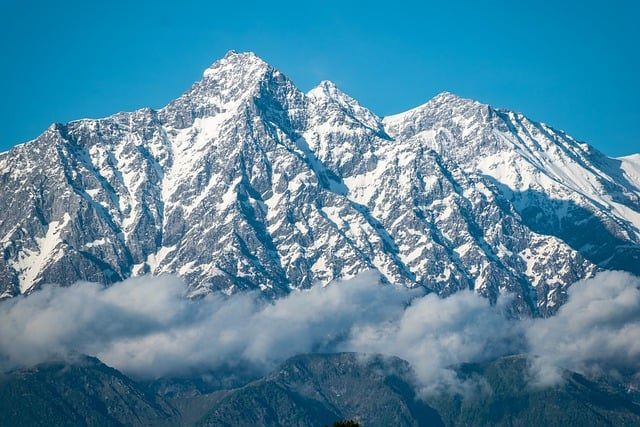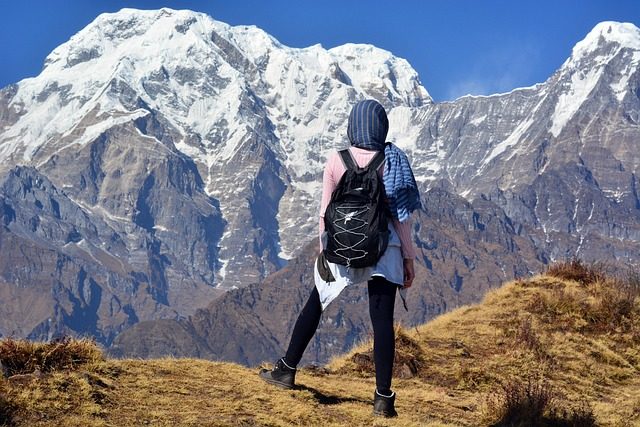The majestic Himalayas, a geological marvel that spans across multiple countries in South Asia, captures the imagination of millions worldwide. This awe-inspiring mountain range, with its unique geological formation, diverse ecosystems, and rich cultural significance, has been a symbol of the region’s unparalleled natural beauty and spiritual importance for millennia. Join us on an incredible journey as we explore the many facets of the Himalayas, from its formation and evolution to its highest peaks and sacred sites, and uncover the efforts taken to preserve this fragile and enchanting landscape.
Table of Contents
Short Summary
The Himalayas are a unique range composed of three parallel ranges with varying geological characteristics, formed through tectonic activity around 50 million years ago.
Its majestic peaks and famous summits offer climbers unparalleled opportunities while its diverse ecosystems support an abundance of endemic flora and fauna.
Conservation efforts such as community based projects by the World Wildlife Fund (WWF) aim to protect resources from climate change for current and future generations.
Formation and Geology of the Himalayas

As one of the youngest mountain ranges on Earth, the Himalayan mountain range boasts a fascinating geological history. They were formed as a result of the collision between the Indian and Eurasian plates, which began around 50 million years ago. This monumental event led to the creation of a prominent mountain range that stretches across several countries, including:
India
Nepal
Bhutan
China
The impressive crustal thickness of the Himalayas ranges between 65 and 80 kilometers over the Higher Himalayas, making it one of the most distinctive geophysical features of the range.
The Himalayan Range comprises three parallel ranges: the Greater Himalayas, the Lesser Himalayas, and the Outer Himalayas, each with its unique geological characteristics. These ranges are home to some of the highest and most renowned snow-covered peaks on Earth, including Mount Everest, which stands tall at an altitude of 29,029 feet (8,848 meters). The remarkable altitude and climate variations within the Himalayas have given rise to diverse ecosystems, such as alpine meadows and coniferous forests, that support an abundance of flora and fauna.
Litho-tectonic Units
The Himalayas can be divided into five litho-tectonic units, each characterized by their unique lithology and tectonic history. These units help geologists better understand the complex structure and formation of the youngest mountain ranges on Earth. One of the most significant tectonic contacts in the Himalayas is the Indus-Tsangpo Suture Zone, a narrow belt of ophiolites and associated sediments that join the Indian continental block with the Tibetan block. This zone provides valuable insights into the collision between the Indian and Eurasian plates and the resulting geological formations.
Each litho-tectonic unit presents its distinct geology, contributing to the diverse landscape and ecosystems found throughout the Himalayas. As the Indian plate continues to push into the Eurasian plate, the Himalayas remain in a state of evolution, with tectonic activity and mountain-building processes still taking place. The ongoing evolution of the Himalayas has a significant impact on the region’s climate, ecosystems, and the millions of people who call this awe-inspiring landscape home.
Ongoing Evolution
The Himalayas are far from static; they continue to evolve and change over time. With the Indian plate still pushing into the Eurasian plate, the region experiences ongoing tectonic activity and mountain-building processes. This constant evolution is part of what makes the Himalayas such an intriguing and dynamic landscape for geologists and adventure seekers alike.
As the Himalayas continue to rise and change, their impact on the region’s climate, ecosystems, and communities is felt on a daily basis. The effects of ongoing evolution can be witnessed in the shifting glacial patterns, the formation of new peaks, and the creation of glacial lakes. Understanding the ongoing evolution of the Himalayas is essential for the development of effective conservation strategies and the sustainable management of this fragile and enchanting landscape.
The Majestic Peaks of the Himalayas

The Himalayas are home to some of the world’s most impressive and majestic peaks. Boasting more than one hundred peaks with elevations exceeding 23,600 feet (7,200 meters) above sea level, the Himalayas have captured the imagination of mountaineers, adventurers, and spiritual seekers alike. Some notable peaks in the Himalayas include:
Mount Everest, the highest peak in the world, standing tall at an elevation of 29,029 feet (8,848 meters)
K2, the second highest peak in the world, with an elevation of 28,251 feet (8,611 meters)
Kangchenjunga, the third highest peak in the world, reaching an elevation of 28,169 feet (8,586 meters)
Lhotse, the fourth highest peak in the world, standing at an elevation of 27,940 feet (8,516 meters)
These are just a few examples of the incredible heights found within the Nepal Himalaya region.
In addition to Mount Everest, the Himalayas are home to numerous other renowned peaks, such as K2, Kanchenjunga, and Annapurna, which attract climbers from all over the globe. Conquering these colossal peaks presents unique challenges, including altitude sickness, inclement weather, and technically demanding routes. Yet, for those who dare to take on these challenges, the Himalayas offer unparalleled experiences and the opportunity to stand on the rooftop of the world.
Famous Summits
The Himalayas boast an impressive array of famous summits that attract climbers and mountaineers from around the globe. Some of the most renowned peaks include:
Mount Everest
K2
Kailash
Kanchenjunga
Nanga Parbat
Annapurna
Manaslu
Each of these peaks presents its unique challenges and allure, drawing climbers to test their skills and determination against these formidable giants.
These famous summits not only offer unparalleled climbing opportunities, but also hold deep cultural and spiritual significance for the people of the region. For example, Mount Kailash in the Tibetan Himalaya is considered the abode of the Hindu deity Shiva and is a revered pilgrimage site for adherents of Hinduism, Buddhism, Jainism, and Bon. The rich tapestry of culture, spirituality, and adventure found within the peaks of the Himalayas is a testament to the region’s enduring allure.
Climbing Challenges and Records
Climbing the towering peaks of the Himalayas presents unique challenges that test the limits of human endurance and skill. From altitude sickness and inclement weather to crevasses on ice and technically demanding peaks, climbers face numerous obstacles in their quest to conquer these awe-inspiring giants. Despite the challenges, the Himalayas have been the backdrop for numerous records and achievements in the mountaineering world.
Some notable records include:
The first successful ascent of Mount Everest by Edmund Hillary and Tenzing Norgay in 1953
The first solo ascent of Mount Everest by Reinhold Messner in 1980
The first female ascent of Mount Everest by Junko Tabei in 1975
These feats showcase the indomitable human spirit and the enduring appeal of the Himalayas, inspiring countless climbers to follow in their footsteps and conquer the world’s highest peaks.
Climate and Ecosystems of the Eastern Himalayas
The Eastern Himalayas, with their varying altitude and climate, boast an incredible array of ecosystems that support a diverse range of flora and fauna. From the lush alpine meadows to the dense coniferous forests, the Eastern Himalayas are home to some of the most unique and fragile ecosystems on the planet. This rich biodiversity is a result of the region’s complex geology and its location at the junction of several distinct biogeographic realms.
The region’s climate plays a crucial role in shaping its ecosystems, with the Eastern Himalayas experiencing a unique combination of monsoon rains and high-altitude conditions. This diverse climate supports a vast array of plant and animal species, many of which are endemic to the area or found nowhere else on Earth.
The Eastern Himalayas are not only a treasure trove of biodiversity, but also a vital source of fresh water and other natural resources for millions of people who call the region home.
Alpine Meadows
Alpine meadows in the Himalayas are home to a stunning array of flora and fauna, thriving at high altitudes where the snow line begins to recede. These meadows are formed as a result of the weathering of rocks, which produces soils suitable for the growth of grasses and sedges. The vibrant colors and delicate beauty of the alpine meadows provide a stark contrast to the rugged, snow-capped peaks that dominate the landscape.
In these picturesque meadows of the Tibetan Plateau, one can find a diverse range of wildlife, such as:
the elusive snow leopard
Himalayan tahr
musk deer
pikas
The alpine meadows also serve as crucial habitats for many migratory bird species, which rely on these areas as breeding grounds and stopover sites during their long journeys.
The protection and preservation of these fragile alpine meadows are essential for maintaining the region’s unique biodiversity and the livelihoods of local communities that rely on these ecosystems.
Coniferous Forests
Coniferous forests, found at slightly lower elevations in the Himalayas, play a crucial role in maintaining the region’s ecological balance and supporting diverse wildlife. These forests are dominated by:
Pine
Hemlock
Spruce
Fir trees
They provide vital habitats for many endangered species, such as the red panda and Asian elephant.
The health and sustainability of these coniferous forests, also known as conifer forests, are closely linked to the region’s climate, as moist air from the monsoon season brings heavy rainfall to the area, nourishing the forests and the countless species that call them home. However, the growing impacts of climate change and human activities pose a threat to these vital ecosystems.
Conservation efforts, such as community-based initiatives and addressing the impacts of climate change, are essential for the long-term preservation of the Himalayas’ coniferous forests and the countless species that depend on them for survival.
For more info, please visit Climate Change in the Eastern Himalayas: Community-based Traditional Ecological Knowledge to Support Biodiversity Conservation.
Rivers Originating from the Himalayas
The mighty Himalayas serve as the source of many major Asian rivers, providing life-giving water and sustenance to millions of people across the continent. These rivers play a vital role in shaping the region’s landscape, ecosystems, and human settlements. The Indus, Ganges, and Brahmaputra are just a few examples of the important rivers that originate from the Himalayas, carving their way through the rugged terrain and nourishing the fertile plains below.
The health and sustainability of these rivers are of paramount importance to the people of South Asia, as they rely on the rivers for drinking water, irrigation, and other essential resources. However, the growing impacts of climate change and human activities pose a threat to the long-term health and sustainability of these vital waterways.
Addressing these challenges and protecting the Himalayas’ rivers is essential for the continued well-being of the region’s people and ecosystems.
Lifelines of Northern India
Rivers originating from the Himalayas, such as the Ganges and Indus, are vital to the livelihoods of people in Northern India. They provide essential water resources for drinking, irrigation, and other purposes. The Ganges, in particular, are considered the lifeblood of India, supporting millions of people who depend on the river for their daily needs.
The health of these rivers is inextricably linked to the well-being of the communities that rely on them, making their protection and conservation a top priority. However, threats such as pollution, over-extraction of water, and climate change pose significant challenges to the long-term health and sustainability of these rivers.
Conservation initiatives, such as community-based efforts and addressing climate change, are essential for safeguarding the lifelines of Northern India and ensuring the continued well-being of the region’s people and ecosystems.
Threats to Himalayan Rivers
The Himalayan rivers face numerous threats, with climate change and human activities being among the most significant. Some of the threats include:
Climate change, which is causing the rivers to become warmer, resulting in decreased water levels and increased sedimentation.
Decreased water availability for drinking and irrigation.
Increased flooding and landslides.
These threats have detrimental impacts on the ecosystem and the communities that rely on these rivers.
In addition to climate change, human activities such as pollution, deforestation, and damming also pose threats to the health and sustainability of Himalayan rivers. Pollution from industrial and agricultural runoff presents a major hazard, decreasing water quality and biodiversity.
Addressing these threats and implementing effective conservation strategies are essential for the long-term protection of the Himalayas’ vital water resources and the millions of people who rely on them for their survival.
The Cultural Significance of the Himalayas
The Himalayas hold deep cultural significance for the people of South Asia, with their rich tapestry of history, mythologies, and religions reflecting the profound connection between the region’s diverse communities and the awe-inspiring landscape that surrounds them. For thousands of years, the Himalayas have been a source of inspiration, spirituality, and adventure for countless generations, their rugged peaks and verdant valleys providing a backdrop for countless stories and legends.
In addition to their spiritual and religious importance, the Himalayan region is home to a multitude of cultures and ethnicities, each with their distinct traditions and customs. These vibrant cultures have adapted to the unique challenges and opportunities presented by the region’s diverse landscape, developing an intricate web of relationships with the environment and the countless species that inhabit it.
The cultural significance of the Himalayas is a testament to the region’s enduring allure and the profound connections that bind its people to the land.
Sacred Sites and Pilgrimages
Pilgrimages to sacred sites in the Himalayas are an important aspect of the region’s culture, with numerous peaks and locations holding deep spiritual significance for the people of South Asia. Some of the most renowned sacred sites and pilgrimages include:
Muktinath
Mount Kailash
Lake Manasarovar
The Char Dham pilgrimage
These sites attract thousands of pilgrims each year, who embark on arduous journeys to pay homage to the divine and seek spiritual solace amidst the breathtaking beauty of the Garhwal Himalaya.
The sacred sites of the Himalayas are not only important for their spiritual significance, but also serve as a testament to the region’s rich cultural heritage. The stories and legends that have emerged from these sites over the centuries continue to inspire and captivate the hearts and minds of countless people, both within the region and beyond.
The sacred sites and pilgrimages of the Himalayas serve as a bridge between the past and present, connecting generations of believers to the timeless beauty and spirituality of the world’s most awe-inspiring mountain range.
Local Traditions and Festivals
Local traditions and festivals in the Himalayas are a vibrant celebration of the region’s unique culture and natural beauty. From the lively dances and music of the Yartung festival in Nepal to the colorful rituals of the Losar festival in Tibet, these events showcase the rich tapestry of customs and beliefs that have developed within the region’s diverse communities.
These festivals not only provide an opportunity for people to come together and celebrate their shared heritage, but also serve to strengthen the bonds between communities and the natural world around them. Through the centuries, these traditions and festivals have evolved in harmony with the environment, reflecting the deep connection between the people of the Himalayas and the awe-inspiring landscape that has shaped their lives.
By preserving and celebrating these local traditions and festivals, the people of the Himalayas are ensuring that their rich cultural heritage is passed down to future generations, who will continue to be inspired by the region’s unparalleled beauty and spiritual significance.
Conservation Efforts in the Himalayas
The fragile ecosystems and vital resources of the Himalayas are under increasing pressure from climate change and human activities, making conservation efforts in the region more critical than ever. In response to these challenges, a variety of conservation initiatives have been undertaken, with a focus on community-based projects and addressing the impacts of climate change.
Organizations such as the World Wildlife Fund (WWF) have played a significant role in supporting conservation efforts in the Himalayas, assisting local communities and governments in managing their forests, streams, soils, and wildlife in a sustainable manner. Through these efforts, the WWF and other conservation organizations aim to preserve the unique beauty and biodiversity of the Himalayas for generations to come, ensuring that the region’s delicate balance of ecosystems and resources is maintained.
Community-Based Conservation
Community-based conservation projects, such as those led by WWF, aim to protect the Himalayas’ ecosystems and improve local livelihoods by empowering communities to take an active role in the management and protection of their natural resources. These projects focus on providing training and support to local communities, enabling them to develop sustainable income-generating activities and improve their quality of life.
Examples of community-based conservation projects in the Himalayas include the Sacred Himalayan Landscape project, which seeks to restore essential habitats and safeguard endangered species in the region. Through these initiatives, local communities are not only contributing to the conservation of their environment, but also benefiting from improved livelihoods and enhanced well-being that come from living in harmony with the natural world.
Addressing Climate Change
Addressing climate change is crucial to preserving the fragile ecosystems and vital resources of the Himalayas. As temperatures rise and precipitation patterns shift, the delicate balance of the region’s ecosystems is at risk, with potentially devastating consequences for millions of people who rely on the Himalayas for their water, food, and livelihoods.
Conservation efforts in the Himalayas must tackle the impacts of climate change head-on, implementing adaptation strategies designed to ensure the long-term sustainability of the region’s ecosystems and resources. These strategies may include the restoration of degraded habitats, the sustainable management of water resources, and the promotion of low-carbon development pathways.
By addressing the challenges posed by climate change, the people of the Himalayas can work together to protect their unique and fragile landscape for future generations.
Summary
The Himalayas, with their awe-inspiring peaks, diverse ecosystems, and rich cultural heritage, have captivated the hearts and minds of people for millennia. As we have journeyed through the many facets of this incredible mountain range, we have explored its unique geological formation, the challenges faced by climbers, the diverse flora and fauna that call it home, and the deep cultural significance it holds for the people of South Asia. With the growing impacts of climate change and human activities, the need for effective conservation efforts has never been more critical. By working together, we can ensure that the timeless beauty and spiritual significance of the Himalayas are preserved for generations to come.
Frequently Asked Questions
What are the Himalayas best known for?
The Himalayas are the highest mountain range in the world, known for their 9 out of 10 highest peaks, including Mount Everest. They are also referred to as the Third Pole, providing the source of some of Asia’s major rivers and playing an important role in climate regulation.
What countries is the Himalayas in?
The Himalayas span across five countries, namely China, Nepal, Bhutan, India and Pakistan. They cover land controlled by these countries and are situated in South Asia, southwest to China, north to Nepal and Bhutan, northeast to India and Pakistan.
What are 3 facts about the Himalayas?
The Himalayas are the highest mountain range in the world, containing 9 out of 10 of the world’s highest peaks, including Mount Everest. Spanning 2500 km and with an average width of 200 miles, they are home to 30 peaks over 24,000 feet and affect air and water circulation systems, as well as covering 75% of Nepal.
Furthermore, scientific tests have discovered that the Himalayas are still growing in height.
Can anyone go to the Himalayas?
Yes, you can travel to the Himalayas on your own or by booking a tour, especially during the warmer months and winter.
It is possible to explore the region independently, or you can join a tour group for a more structured experience. There are many tour operators offering packages to suit all budgets and interests. Whether you are looking for a cultural experience or not, whether you are looking for a cultural experience or not.
What are some of the highest peaks in the Himalayas?
The Himalayas are renowned for their high peaks, including the iconic Mount Everest as well as K2 and Kanchenjunga.









